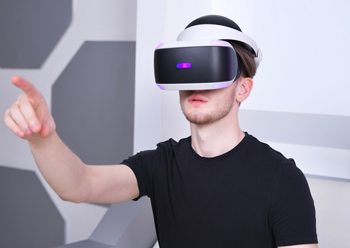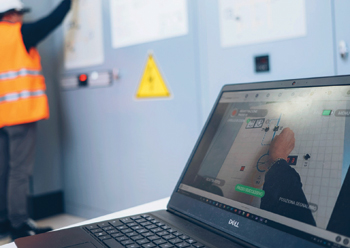
 Manufacturing industry has shown the most promise and return when adopting AR
Manufacturing industry has shown the most promise and return when adopting AR
Digitisation has been a steadfast trend in the enterprise space for years, with IoT, the cloud, collaboration tools, and a handful of other key enabling technologies driving digital adoption. Artificial Intelligence (AI) and analytics, new connectivity types like 5G, digital twins, and other integrated enterprise systems like Customer Relationship Management (CRM) and Product Lifecycle Management (PLM) all work in tandem to create a digital thread. However, this digital thread misses a human-facing element, which Augmented Reality (AR) can provide. As a result, AR meshes perfectly with digitisation efforts and can be part of any company’s digital transformation journey.
AR has been around in its current form arguably since 2013 with the launch of Google Glass. Since then, similar hardware from competitors have proven popular, and the advent of Mixed Reality (MR) glasses has enabled immersive, spatially-aware experiences. Smartphones and tablets also have gained AR capability, leveraging existing cameras and sensors for a similarly spatial, albeit handheld, AR experience.
According to global technology intelligence firm ABI Research, total revenue in Systems Integration and Platform & Licensing for Augmented Reality (AR) will reach over $50 billion by 2027. This is driven by increasing digitisation efforts broadly across enterprises, with augmented reality increasingly a part of these efforts.
 |
“Integration has been a sticking point for many companies implementing augmented reality,” says Eric Abbruzzese, Research Director at ABI Research. “Every company is at a different stage of digitisation, with different platform needs. There is no universal approach for an AR integration as a result, and so AR platform players have made integration and customer flexibility a priority. This has been joined with shifting business models and go to market thinking, as SaaS offerings and more horizontal market approaches better service these priorities.”
As companies digitise, more systems are available to integrate with and would be valuable to do so—IoT, data lakes and AI, PLM/ERM, MDMs, and more. These systems can provide value to an AR user, and the AR user can also empower these systems with user-level data capture. This two-way relationship is rare and incredibly potent but takes some integration effort to work. Connectivity, security, device management, and data compatibility must all be accounted for.
Some companies have realised the value of all-in-one solution portfolios that include AR. PTC, Siemens, SAP, Oracle, and Autodesk are notable operators that expand AR with IoT, PLM, CRM, CAD, and other capabilities under one roof. By still offering third party integration, customers have the freedom to mix and match platforms for their unique and changing needs. More specialised AR players have ensured interoperability with non-AR solutions as well, often including professional services to ensure a smooth implementation.
Some AR use cases can deliver significant value with little to no integration—such as remote expertise—but every use case is improved with deeper integration. “Platform providers and systems integrators are adjusting to a dynamic AR market, with unique needs for every end customer, by prioritising flexibility. Cloud-native and As-a-Service solutions can scale and shift quickly with customer needs while ensuring cross-compatible operation. As enterprises digitise quickly that flexibility is critical to support differing priorities. Flexibility, however, cannot come at the expense of platform providers’ depth of expertise and capabilities,” Abbruzzese concludes.
AR use cases span a range of industries. Operations that have complex environments and processes, and thus suffer the most from downtime and inefficiency, have adopted AR early and will continue to do so. The manufacturing, logistics, energy & utilities, healthcare, automotive, and government & military sectors have shown the most promise and return when adopting AR. Downtime can cost thousands of dollars a minute, and leave gaps in vital service. These verticals also benefit from broader digitisation efforts and integration, with more connected product, processes, and people.
SUCCEEDING THE JOURNEY
With so many moving parts, evolving digitisation and AR together is a constantly changing situation. There is no singular proven approach for every company, but there are proven areas of focus and understanding to keep in mind.
• Identify the actual needs for targeted use cases. Hands-free will likely be the first critical feature of an implementation to understand and will dictate much of the discussion afterward. If hands-free data access is required, then smart glasses are the solution of choice. If hands-free is not a requirement, then mobile device AR may be acceptable and would save on Capital Expenditure (Capex), and likely Operational Expenditure (Opex), over smart glasses. Many features of AR span both mobile and glasses today. Value adds like correct scale visualisation, spatial tracking, and virtual assistant usage are possible across both device types.
• Combining use cases is a logical next step for scaling up AR operations. For instance, integrating step-by-step instruction with live remote assistance can ensure the highest degree of process efficiency, or enable training in real time for instantaneous onboarding/ramp-up.
• Understand required content and content creation elements. Creating entirely new content for use in AR is not necessary, with many platform partners specialising in content optimisation. Models in 3D, Computer Aided Design (CAD) files, and traditional digital documents can often be ported over to work in AR relatively easily. Digitising and optimising non-digital content (such as instruction manuals or checklists) creates an extra challenge, but along with other digitisation efforts, this is usually not a significant barrier.
• Partner prolifically across the ecosystem with hardware vendors, cloud providers, systems integrators, specialised AI/ML vendors, telcos, and infrastructure providers. For the customer, there are no downsides to a broad platform partner library, just more choice. It takes time and effort to land and maintain partnerships, but it hedges against market dynamic shifts and creates a more comprehensive and flexible overall portfolio.
• Recognise the possibilities for consumer smart glasses for enterprises. Prepare MDMs to be able to incorporate these devices if not already capable. Understand the hardware needs for use cases and where consumer devices fall short (e.g., safety certifications).
• Ensure investment in AI and analytics. AI/ML and, more broadly, analytics are powering next-generation use cases, so as customers look to scale up and expand capabilities, AI will be a requirement. More time in the market will mature offerings, and in the case of ML, can have a powerful compounding effect on AI accuracy, capability, efficiency, and more.
• Cloud-hosted capabilities are the norm now; edge compute and Software-as-a-Service (SaaS) are forward looking. Position offerings in line with this, with flexibility for the cloud, on-premises, and hybrid when possible. Business models spanning traditional, SaaS, and otherwise will help cover most facets of the AR market today and going forward.
• Ascertain realistic digitisation needs and how that combines with AR. Over the top (e.g., light integration) AR implementations can still be valuable, especially in high-value use cases (e.g., remote assistance), but all provide greater value with greater integration. The scale and complexity of existing infrastructure, such as connectivity solutions and non-AR platforms like the IoT, can also dictate the level of investment; deep end-to-end integration is quicker and easier if end-to-end only includes a few connection points.
• Prepare for increasingly horizontal and cross-market solutions to come. Metaverse is the AR buzzword of choice currently, and while most conversation is around the consumer space, some of the trends at the foundation of that conversation are universal. There are already the beginnings of horizontal enterprise approaches with platforms aiming for fully device-agnostic portfolios in many scenarios. Companies that have traditionally been siloed and not seen as competitive can easily expand capabilities and footprints to become competitive. Web3, and many narrower attempts at decentralised services, will disrupt some approaches to communication and content distribution.
Killer use cases for enterprise AR have already been identified, and are rapidly expanding due to value being realised in worker enablement and immersive engagement. Contextual AR offers new opportunities to digitally transform processes with spatial awareness, while AI/ML and state detection empowers users with personalised guidance and predictive insight. With a confluence of mature enabling technologies and realised value, now is the time to examine AR as part of a digital transformation journey.





